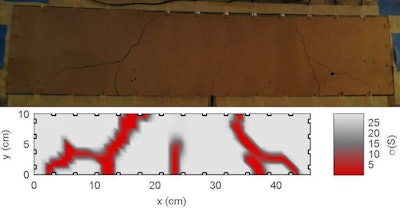
A new paint-on “sensing skin” would allow officials to retrofit bridges and other concrete structures with the ability to detect cracks or other weaknesses before they spread beyond repair.
While many new structures today are built with strain sensors, this new technology would provide officials with an easier way to outfit existing critical concrete structures such as bridges and and nuclear facilities with an early warning system.
The system is being developed by a team of researchers from North Carolina State University and the University of Eastern Finland and consists of a conductive coat of paint and a series of electrodes. The paint can actually consist of any number of conductive materials such as copper and researchers say it is relatively inexpensive.
To install the system, the electrodes are installed around the perimeter of the structure and the “skin” is then painted onto the structure and over the electrodes. Then, a small electrical current is run between two of the electrodes at a time, cycling through number of possible combinations.
Because the paint’s conductivity decreases due to cracks or weaknesses in the underlying structure, after the current runs between the electrodes a computer program can sense weaknesses in the structure and even pinpoint their location by measuring the strength of the current after it runs through the painted-on skin.
So far, the researchers have tested the system on concrete beams about three feet wide and the results have shown the system to be accurate. The next step is to begin testing on larger structures.









